One of the youngest brands to join the Swatch Group lineup has one of the oldest watch brand names: Jaquet Droz. And in 2021 the brand celebrates the 300th anniversary of the birth of its founder, Pierre Jaquet-Droz, who was born in La Chaux-de-Fonds, Switzerland, in 1721.
Although at the beginning Jaquet Droz was not intended to compete with the group’s top-shelf brands – Breguet, Blancpain, and more recently Glashütte Original and Harry Winston – the young marque quietly entered the running without trying. Its limited and quite rare timepieces are created using all of the combined knowledge and technical firepower the Swatch Group has at its disposal. And that is a lot.
And what appeals to me is that within the Swatch Group’s 190 separate companies, including 18 brands, Jaquet Droz operates very much like an independent watchmaker. And its artful timepieces reflect this.
Pierre Jaquet-Droz’s horological beginning
Between the years 1738 and 1747, Pierre Jaquet-Droz concentrated on clockmaking under the tutelage of master watchmaker Josué Robert and his two sons David and Louis-Benjamin.
Displaying talent, he began combining his clock movements with music and automata. He earned himself a reputation, and wealthy clients came from near and far to purchase his output. To supply his mechanical marvels with worthy casings, Pierre traveled from Switzerland to Paris to find good cabinet makers and bronze smiths.
Devoting himself entirely to the production of his high-quality products by 1755, Jaquet-Droz was urged by the governor of the principality of Neuchâtel to present his clocks abroad. The governor had a good contact on the Spanish royal court, an important nobleman, and arranged for Jaquet-Droz to be presented to King Ferdinand VI of Spain.
Seizing the opportunity Pierre, his father-in-law, and a young employee by the name of Jacques Gevril set to work building a special transport for six clocks. The journey to Spain by carriage in 1758 took 49 days, and the party was received and hosted by the nobleman Jacinto Jovert.
Five months later, Jaquet-Droz presented his creations to the king of Spain, and they were an instant hit. All of the pieces he brought, including automata such as a dog that barked when someone attempted to touch its basket of fruit, were purchased by an astonished royal pair for their palaces in Madrid and Villaviciosa.
Pierre and his father-in-law left the Spanish court eight months later (Gevril remained behind to work as a clockmaker there).
Jaquet Droz’s exquisite automata
After 1773, “Jaquet Droz and Leschot” created ever more exquisite automata – the company name now reflected the fact that Pierre had made the son of a neighbor, a man he treated as an adoptive son, and his own son Henry-Louis, partners.

The Writer by Jaquet Droz
The highlight of this company’s career was without a doubt the creation of three life-size humanoid figures dubbed the Writer, the Draftsman and the Musician. These robotic automata today known as “the androids” drew onlookers from all over the world.
The androids are meanwhile very well-traveled, although they have finally found a permanent home in the Museum of Arts and History in Neuchâtel. Here they have a little theater dedicated to them, with the renovation and upkeep being sponsored by the modern Jaquet Droz brand. Upon request, a technician gladly activates the three figures and runs a 15-minute movie on the life and times of Pierre Jaquet-Droz, one of the region’s most revered sons.
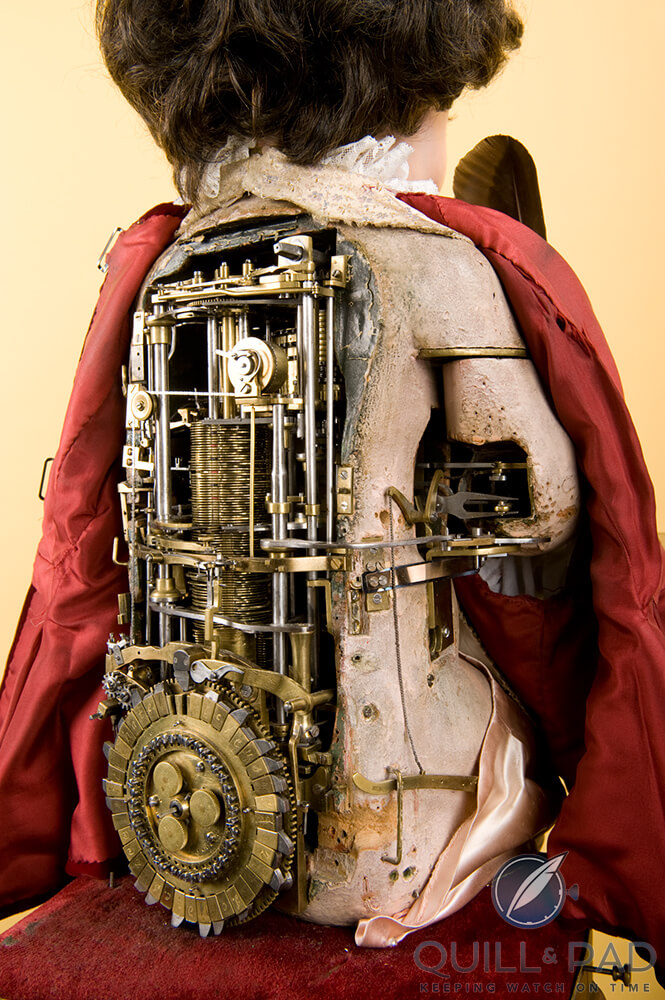
The complex mechanics and system of cams responsible for the lifelike movements of The Writer
Observing the figures in action, it is easy to understand why Jaquet-Droz was once made to take the figures apart to show that they were indeed mechanical, as he was under suspicion of witchcraft.
The Musician actually “breathes” as she plays one of her several pre-programmed melodies on the harpsichord.
The Writer, no less astonishing, dips his quill in ink to complete a pre-programmed message that the visitor may take home as a souvenir. The Draftsman draws with a pencil – and creates sketches that can rival a living artist.
The little company, which had consisted of the inseparable trio of Pierre Jaquet-Droz, his son Henry-Louis, and Jean-Frédéric Leschot for years, was rapidly expanding due, among other things, to its many successes at various European courts.
For health reasons, Henry-Louis needed to leave La Chaux-de-Fonds, and in 1784 he moved to Geneva to set up a horological workshop, launching the production of very complicated pieces.
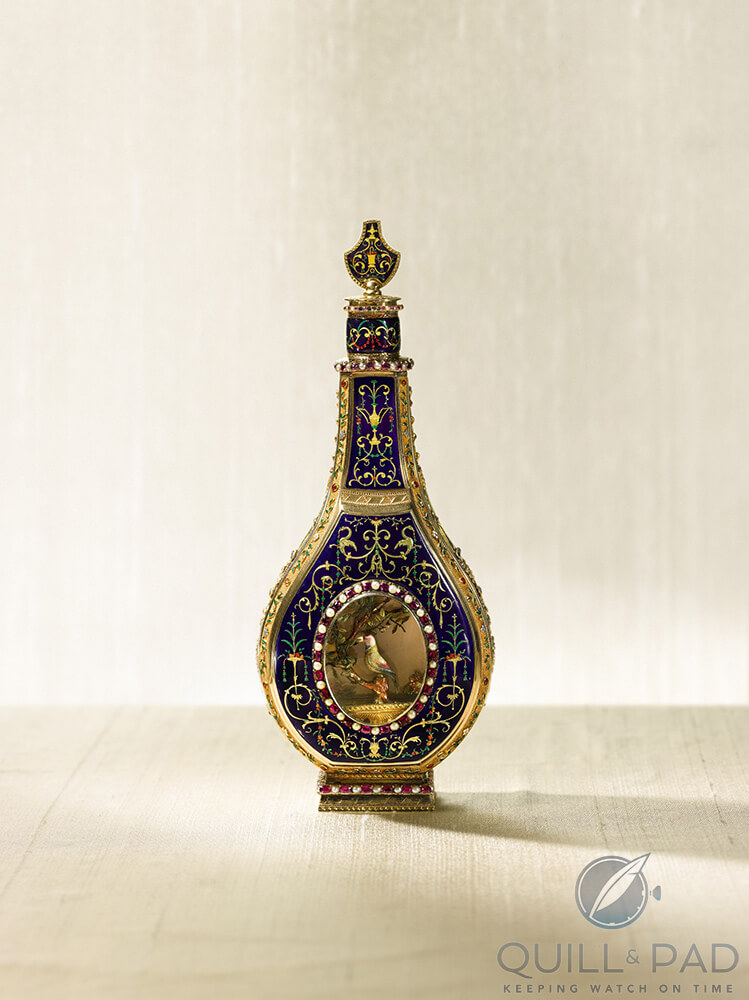
Scent flask with singing bird by Pierre Jaquet-Droz circa 1785
By 1785, Jaquet-Droz had also miniaturized a mechanically controlled bird and developed a compact movement to control its motions. He was successful in recreating realistic birdsong by using a single bellow of variable pitch with a sliding piston rather than multiple single-pitch bellows that were commonly used up until then. It was this invention that led to the singing bird snuff boxes that were so successful in China, one of his main markets.
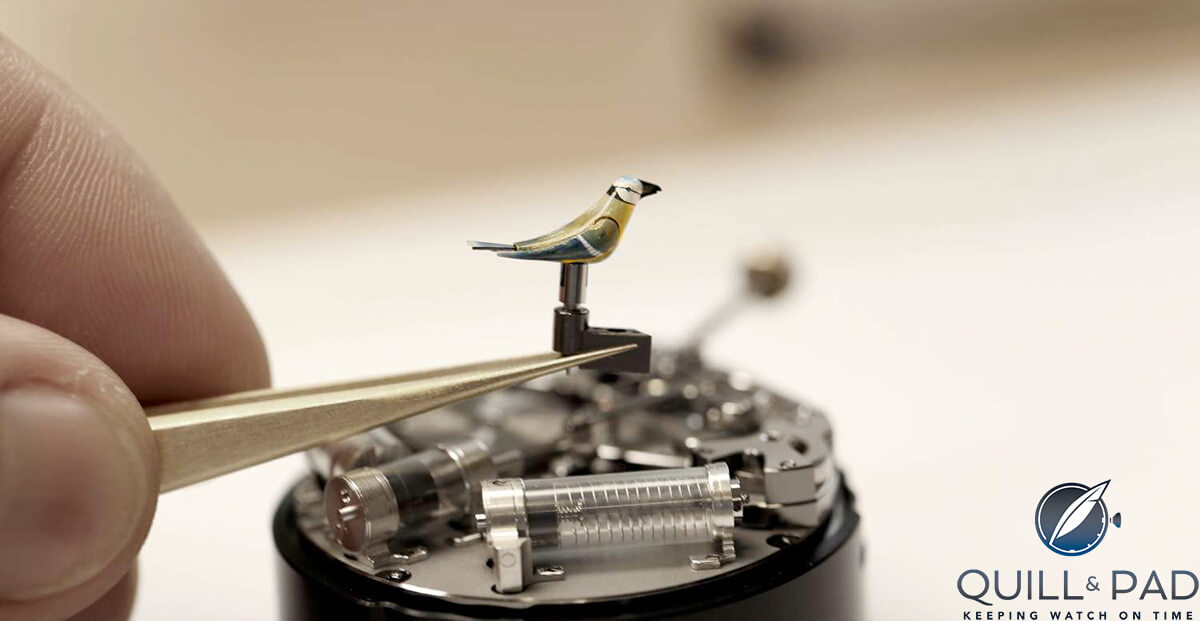
The intricate mechanism and tubes that create the melodious bird song of 2015’s Jaquet Droz Charming Bird
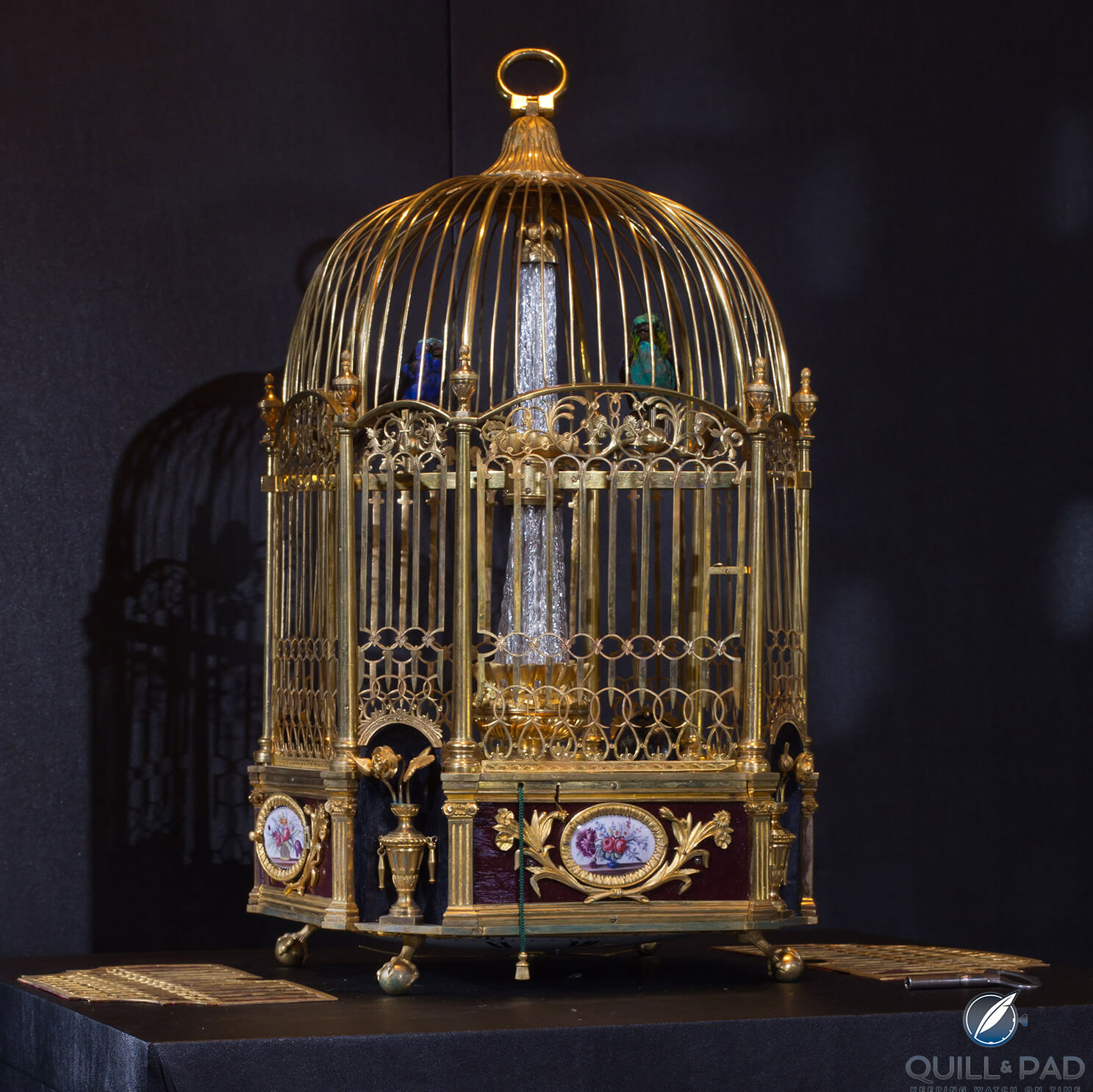
A vintage Jaquet Droz singing bird in cage on display in China in 2011
One of his most capricious inventions was a wall clock whose dial formed the base of a full-size bird cage. As the cage was made to hang like a real bird cage, the dial was underneath and seen from below. The cage also contained one or two singing bird automata whose song was made to seem like a conversation between them. In rare instances, a mechanism was incorporated that allowed the “birds” to “jump” or “fly” from one perch to the other.
Jaquet Droz internationally expands and retracts
Jaquet-Droz, now in possession of three production workshops located in La Chaux-de-Fonds, Geneva, and London, reached the height of its career in 1788.
A force in Swiss luxury, it produced complicated timepieces and automata such as singing birds and musical snuff boxes. After experiencing some financial difficulty due to bankruptcies abroad, Pierre Jaquet-Droz died in 1790.
His son Henry-Louis replied in kind, passing away the following year during a trip to Italy with his wife. The deaths of his partners and the bad economic situation that had arisen due to the Napoleonic Wars severely hindered Leschot in carrying on in the same manner.
He did not actively create new models in the aftermath, only producing variations of those that had been created in the company’s heyday. By 1810 Henry-Louis appears to have ceased trading.
However short-lived it may have been, Pierre Jaquet-Droz and his little company left behind a legacy of complicated and wondrous timepieces and automata. Many of his original creations are still exhibited in the collections of the royal courts of Europe, the Middle East, and especially China.
From 1989: modern Jaquet Droz
The modern Jaquet Droz story began in 1989 when Investcorp, a Saudi-English company that already owned Breguet, Chaumet and Ebel, bought the rights to the Jaquet Droz brand name. A new line was conceived, designed, and launched by the makers of the modern Breguet brand (see Book Review: ‘Breguet, Story Of A Passion 1973-1987’).
In 1994 a few of Investcorp’s leading people went independent, taking the two brands with them and eventually selling them to the Swatch Group in April 2000. The Swatch Group’s first plan of action was to restore the brand according to its roots but in a modern way.
First steps were taken by financially supporting the Neuchâtel Museum of Arts and History, where the androids and the largest collection of vintage Jaquet Droz pieces are housed. Another organization in the region, the Neuchâtel Society of History and Archaeology, had acquired the androids in 1906 for 75,000 gold francs; they reached their final home in 1909.
The second largest collection of Pierre Jaquet-Droz’s work can be viewed at the Patek Philippe Museum in Geneva, by the way.
The new company returned to the exact building in La Chaux-de-Fonds where everything began in 1738, though modern Jaquet Droz has meanwhile moved to a purpose-built factory next to Greubel Forsey just outside La Chaux-de-Fonds.
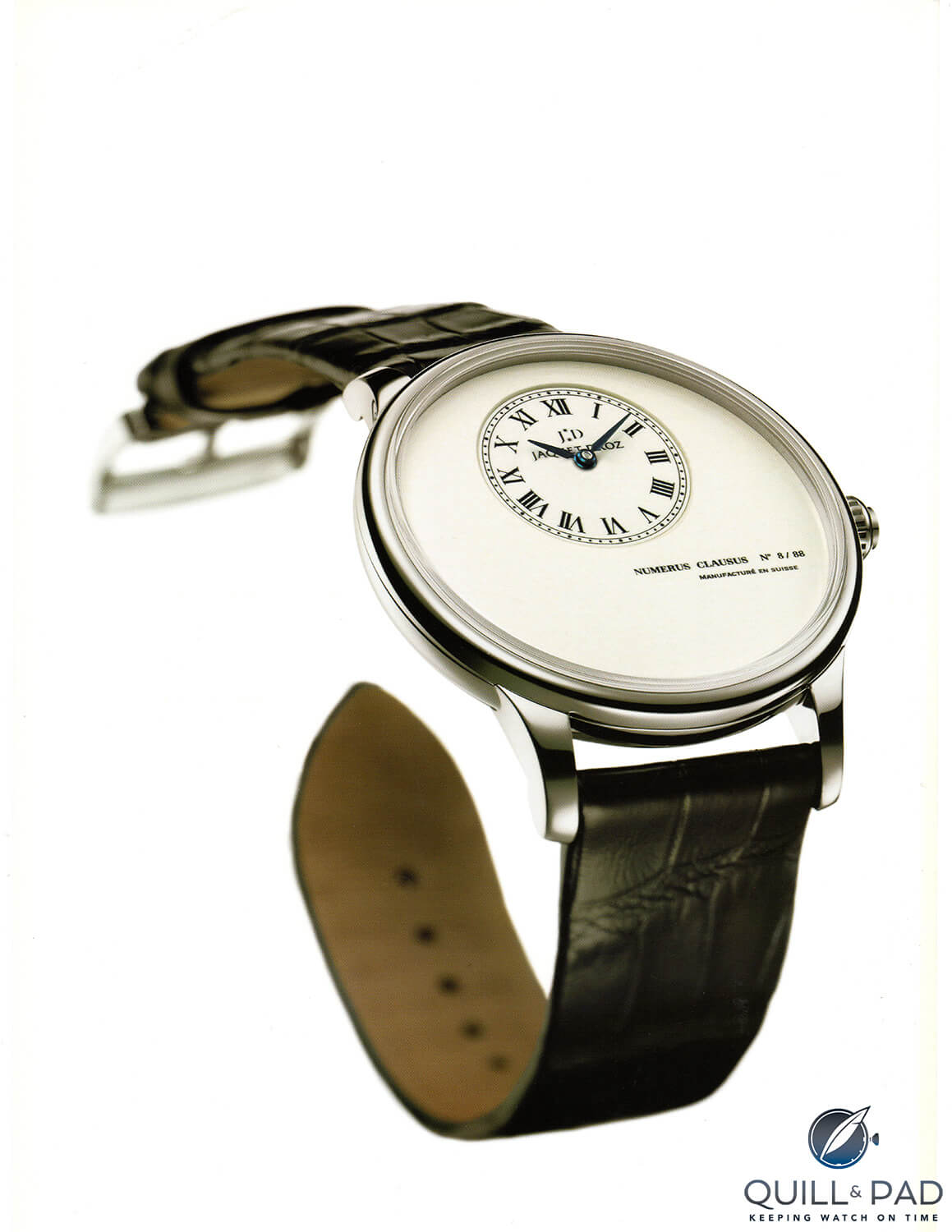
Jaquet Droz’s Petite Heure Minute Email from 2002 in a 43 mm white gold case
The young team, originally headed up by Manuel Emch after the Swatch Group takeover, revamped the collection and its presentation, culminating in a collection shown at the 2002 Basel Fair worthy of Pierre Jaquet-Droz.
At the 2003 Basel Fair, the brand presented further timepieces to delight the senses, all remaining true to the spirit of the original creator, often reinterpreting original pocket watches designed by the master and his partners – an interesting way of presenting the original philosophy, including the technology.
Even then, the dials were decorated using techniques of old, including handcrafted artwork such as high-fire enamel, cloisonné, paillonée, and flinqué to revive the originality of the brand in the truest sense.
Modern Jaquet Droz timepieces are manufactured according to all of the collected experience and know-how the entire Swatch Group has to offer. Their movements were originally based on automatic Frédéric Piguet (now called Blancpain Manufacture) calibers that were modified and reworked so much that they might now be considered as proprietary. For several years now, Jaquet Droz has been using silicon balance springs in these movements just like Blancpain.
In an interview with Emch in the early 2000s, he explained to me, “Pierre Jaquet-Droz did not invent groundbreaking watch technology like Breguet with the tourbillon – Droz’s inventions were of a more aesthetic and emotional nature. Such decoration on a watch had not been done until then. The singing birds, the automaton systems he invented to get the birds in the watches, those are the things that Pierre Jaquet-Droz did to create emotional and aesthetically pleasing timepieces. Enormous technology is hidden behind this, but also an aesthetic value. It is this philosophy that we are trying to recreate.”
Today, the brand continues along its path under the direction of CEO Christian Lattmann. With decades of experience in the Swatch Group – Lattmann’s career encompassed Longines, Omega, and Breguet, where he became vice-president of product management and later executive vice-president – he passionately makes good decisions that foster the spirit of the brand. Lattmann took over from Marc Hayek as CEO of Jaquet Droz in 2016.
New and old traditions at Jaquet Droz
One new tradition at Jaquet Droz that came about during the early 2000s is the use of the number eight as a “lucky number.”
Because Pierre Jaquet-Droz’s company did so much business in China, the modern company chose to use the number 8 as a leitmotif of sorts as it is generally viewed as a lucky number in the Far East.
The “eight” shape is now used as the basis for many special characteristics on the brand’s watches, including the designs of many of Jaquet Droz’s dials.
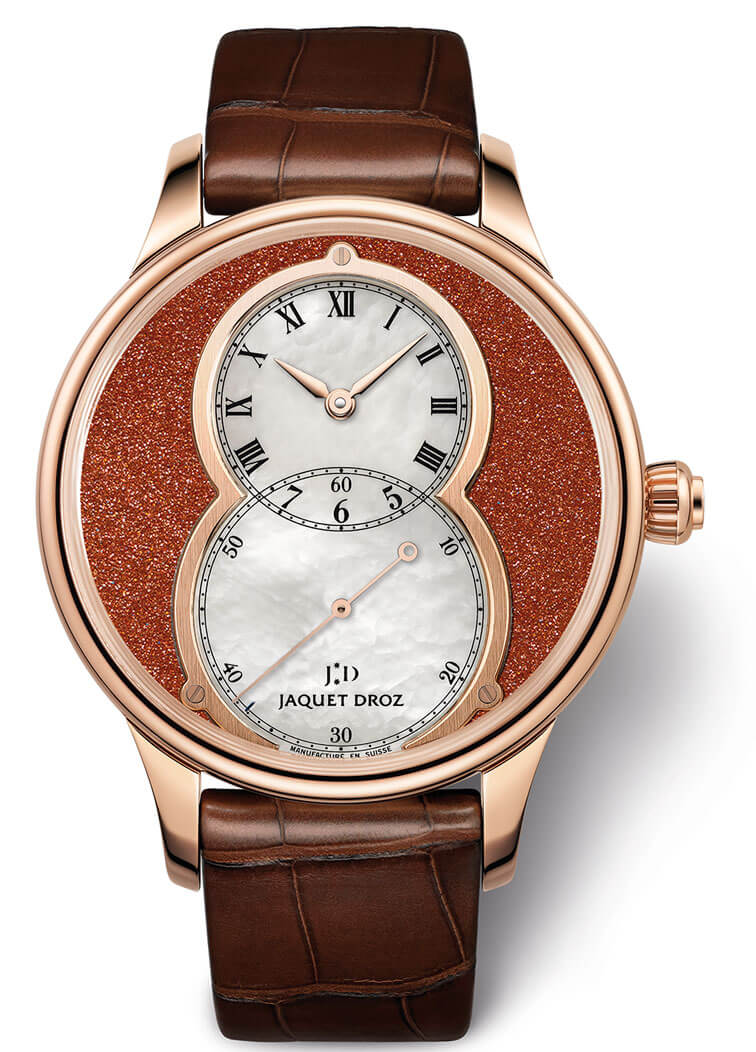
Jaquet Droz Grande Seconde Cerclée Sunstone
In addition, limited editions at Jaquet Droz are never called “limited editions,” but rather “numerus clausus” (Latin for “restricted number”) and are usually offered in sets of 8, 28, or 88 pieces.
Another tradition is the revival of Pierre Jaquet-Droz’s clover leaf. Like the more commonly known secret signature of Abraham-Louis Breguet, Pierre Jaquet-Droz signed his works using a clover leaf.
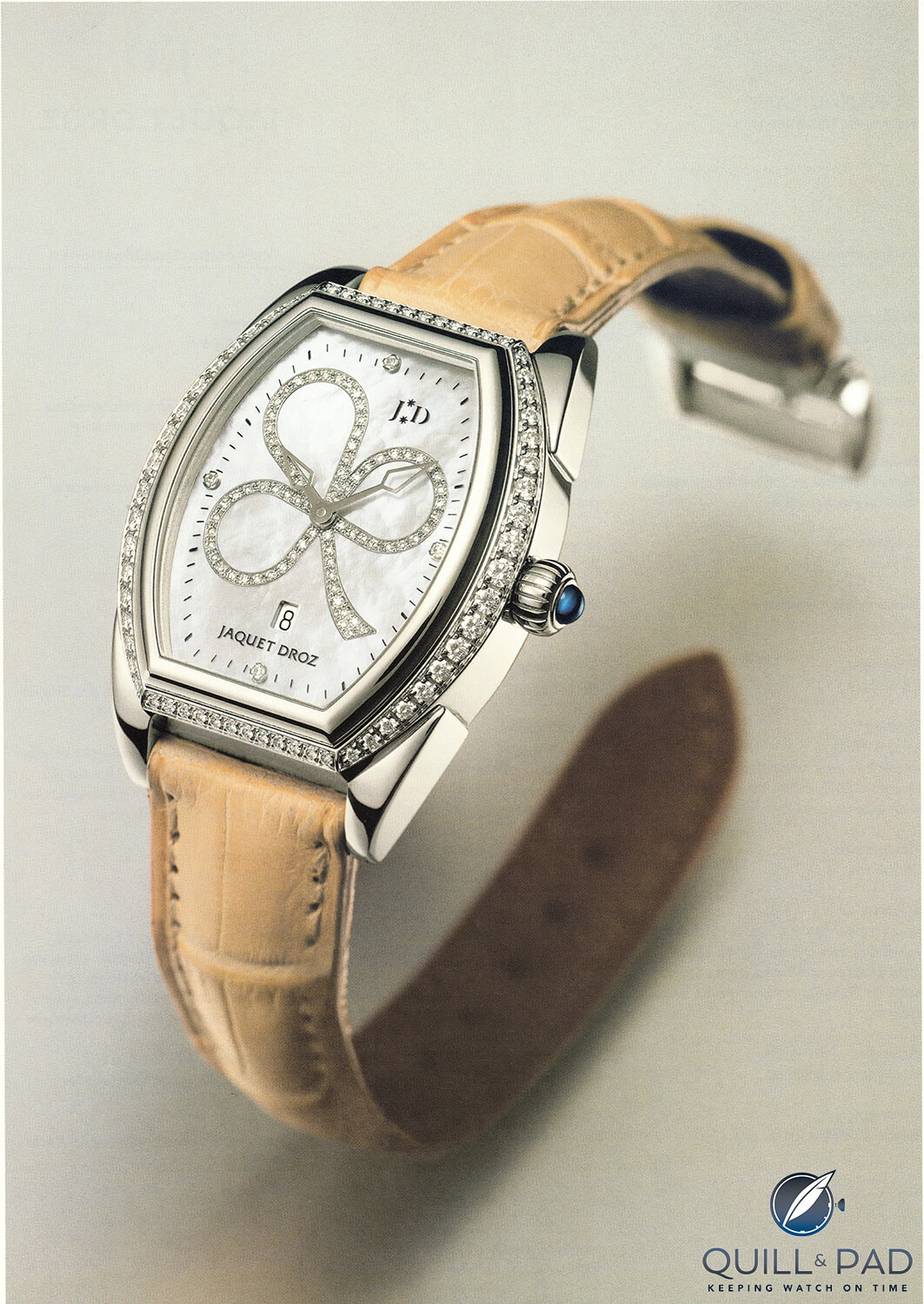
This Jaquet Droz Tonneau Lady from 2002 displays the clover leaf on its mother-of-pearl dial as part of the watch design
This emblem finds itself in use in the modern brand both on the dials of some earlier models and as a signature on the lower left-hand corner of all of the brand’s movements.
Modern Jaquet Droz timepieces have a trademark look that is immediately identifiable. Emulating Jaquet-Droz’s pocket watches, these wristwatches are endowed with lots of large, open space on the dial that is amplified by the absence of a bezel. Also, their look is always minimalistic even when it is overwhelmingly artistic.
Today, the butterfly is also often used to embellish Jaquet Droz timepieces. This dates back to a motif discovered in an old book about Jaquet Droz as well as a fun fact about the Draftsman, Pierre Jaquet-Droz’s legendary eighteenth-century automaton, who was originally programmed to draw a scene involving Cupid driving a chariot pulled by a butterfly.
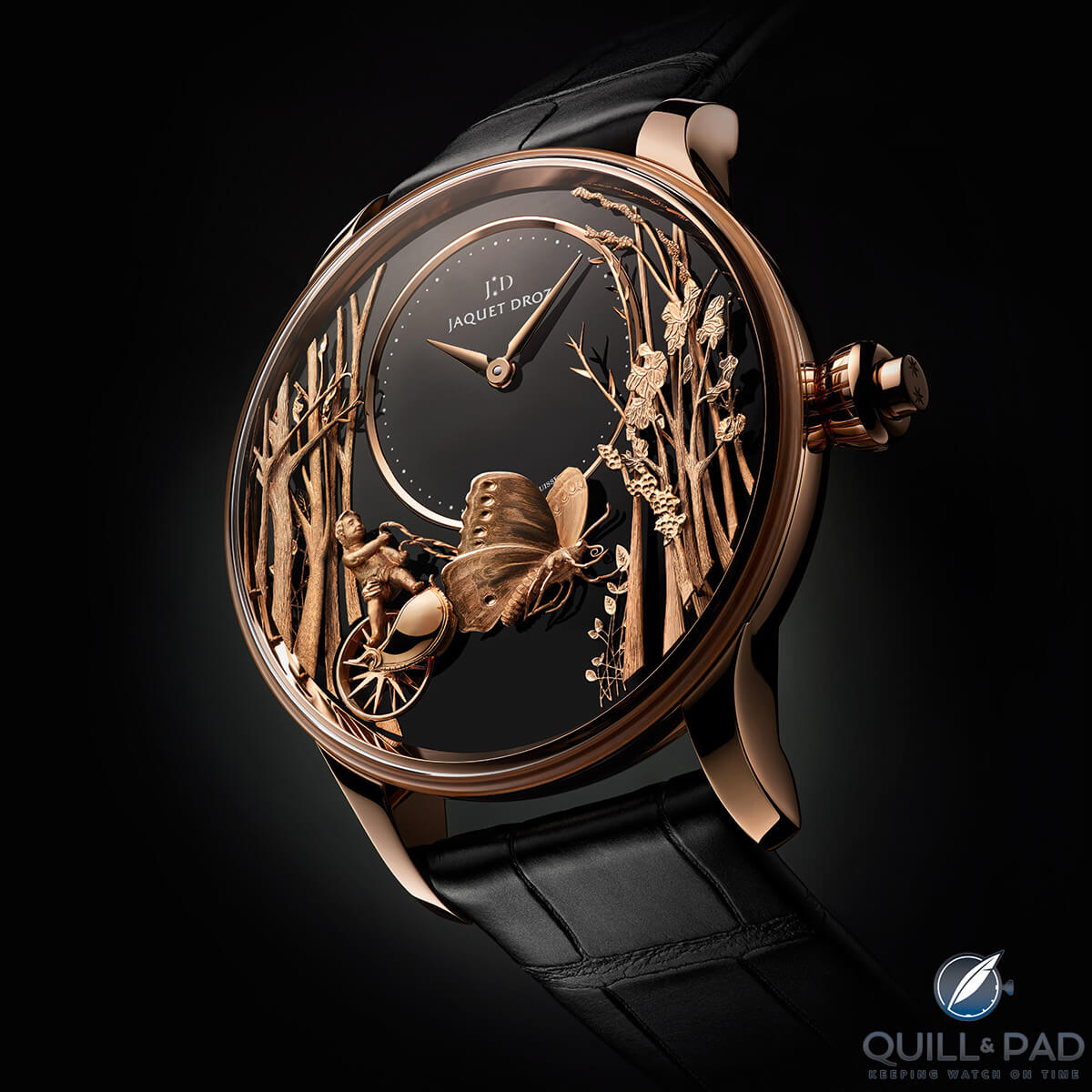
Jaquet Droz Loving Butterfly automaton in pink gold
See more about the brand’s butterflies in Jaquet Droz’s Petite Heure Minute Butterfly Journey: A Unique Horological Flip Book.
Métiers d’art and rare minerals as a signature element
Right off the bat, the Jaquet Droz team practically cornered the market for using rare minerals as dials, a real coup since the dial is what gives any watch its true character.
What to a layperson’s eye could be a “piece of rock” becomes a rare and beautiful dial here. Finding the part of the stone that would make for the most beautiful dial is the second part of this art form after finding the stone itself: graining and rutile segments can look much different on varying parts of a stone, and it takes a highly trained eye to find just the right cutaway to make a dial a few centimeters across to highlight the beauty of the material just so.
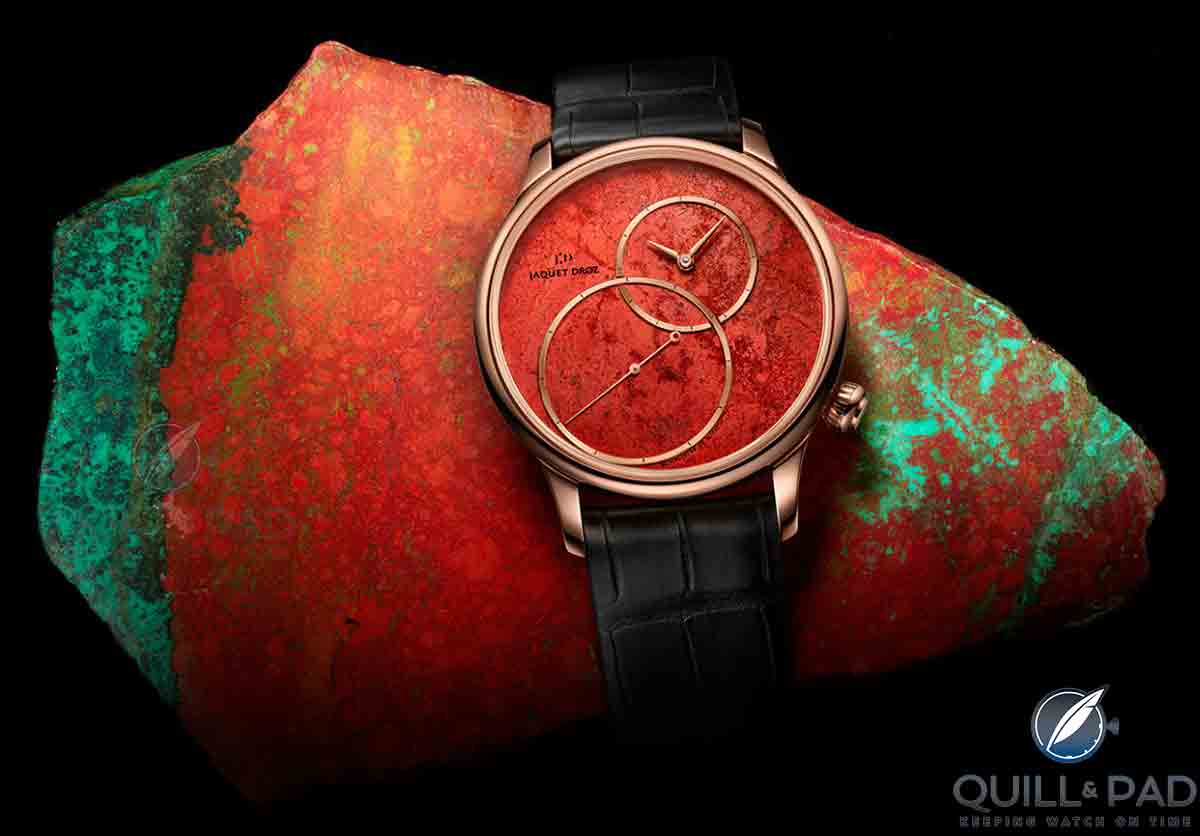
Jaquet Droz Grande Seconde Off-Centered Cuprite for Only Watch 2017
These stones can be any one of a myriad of interesting semi-precious gems, including lapis lazuli, rhodonite, Venus hair, onyx, ruby heart, rutile quartz, obsidian, Kandertal slate, and spectrolite, real rarities like meteorite and fossils, or beautiful gemstone quality slivers in opal (see Shrouded In Mystery And Fire: Opals In Jaquet Droz And Piaget Timepieces).
Despite being part of a major watch group, thanks to the artisanal métiers in which it had begun to excel, Jaquet Droz became a brand with a very personal mindset when it comes to clients. The artisans who decorate the dials of a Jaquet Droz timepiece make every single one of them a one-of-a-kind masterpiece.
These include not only the rare precision-chosen and -cut minerals, quartzes, fossils, and stones that have adorned some of the watches’ spacious dials, but also the art form that one famously associates with this Swiss brand: enameling.
Whether it is miniature painting in high-fire enamel or the enamel art form known as paillonée with its flecks of gold, Jaquet Droz also offers its appreciative clients the chance to express themselves through personal customization.
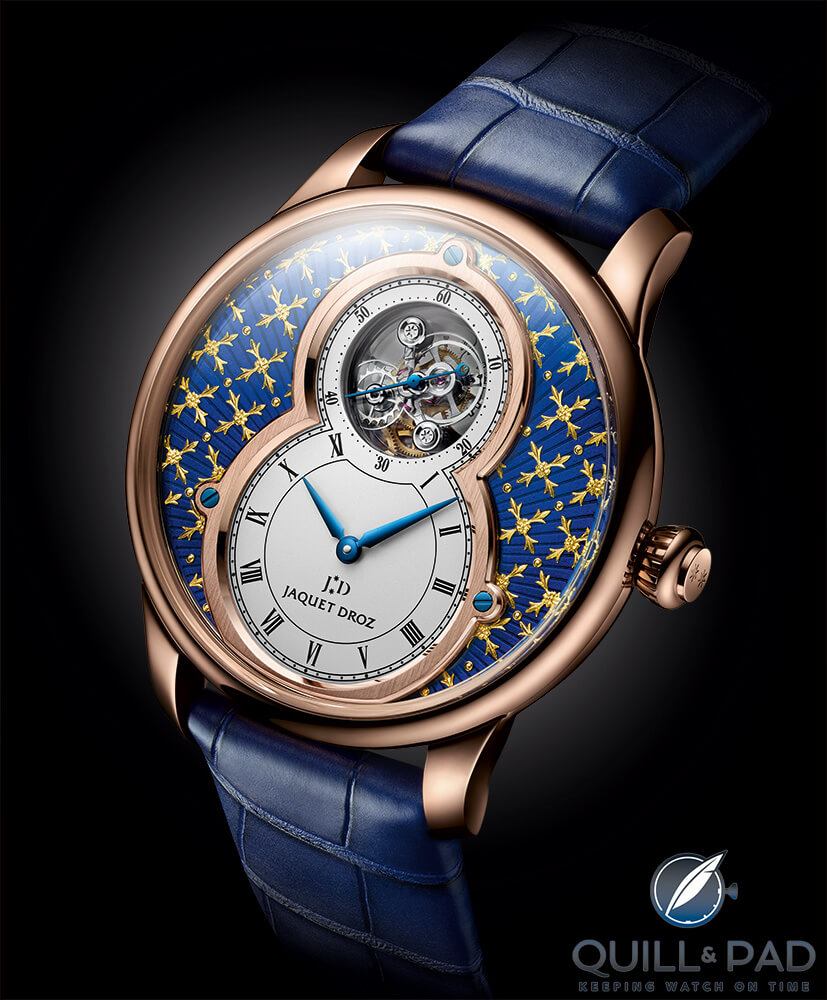
Jaquet Droz Petite Hour Minute Tourbillon Paillonnée
This begins with a journey to the brand’s factory in La Chaux-de-Fonds, during which the client has the opportunity to select the design, as well as the artistic techniques with which the brand’s own artisans embellish the selected timepiece: rare enamel, precision miniature painting, and charming engraving rank high among aficionados of the aesthetic and mechanical.
Depending on the chosen artisanal technique – and the availability of rare minerals if chosen – clients can usually strap their masterpiece on their wrists within six months, something only possible because the watches are made and decorated right in the factory.
Jaquet Droz Grande Seconde: most important modern model
In 2002 the company presented its signature Grande Seconde model, where the play of the lucky eight comes into the picture. Aside from the Petite Heure Minute, it is the Grande Seconde that forms the base of Jaquet Droz’s daily-wear collection.
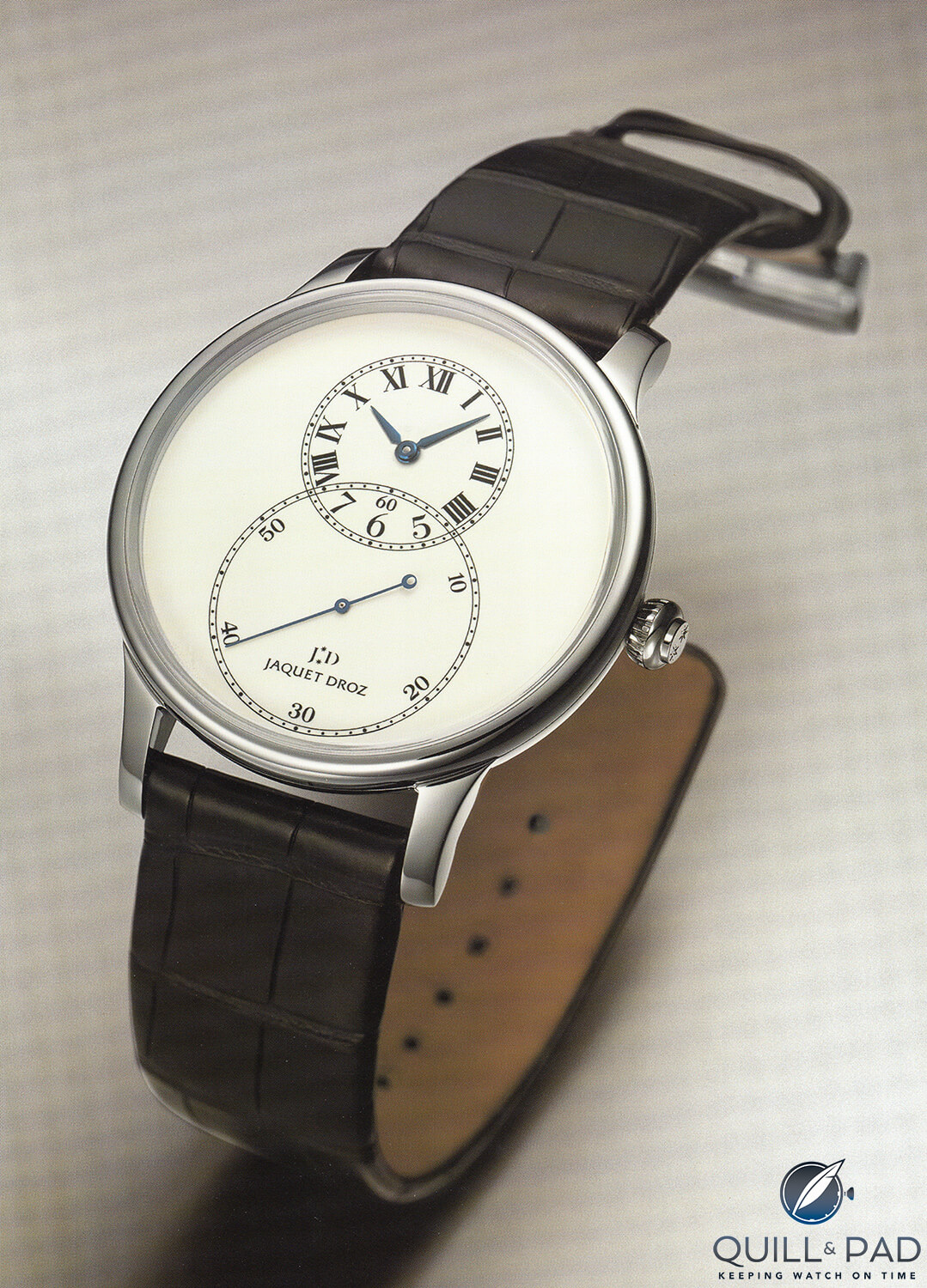
The Jaquet Droz Grande Seconde Email from 2002
At the 2003 Basel Fair the Grande Seconde Décentrée (Off-Centered) arrived, featuring a sideways potbellied eight in ivory-colored high-fire enamel. This, too, has been a lasting design.
Jaquet Droz’s emblematic Grande Seconde line originates in a pocket watch from 1784 that was created by Pierre Jaquet-Droz himself. As he lived during the age of enlightenment – an intellectual movement centered around reason – and as a scientific designer he was very aware of symbolism. It was probably not coincidence that he chose the perfect beauty of the figure 8 to express dualism and balance in his typical dial designs: the circles of the hour-and-minute as well as the large second subdials form a striking and proportionate “8” on the dial.
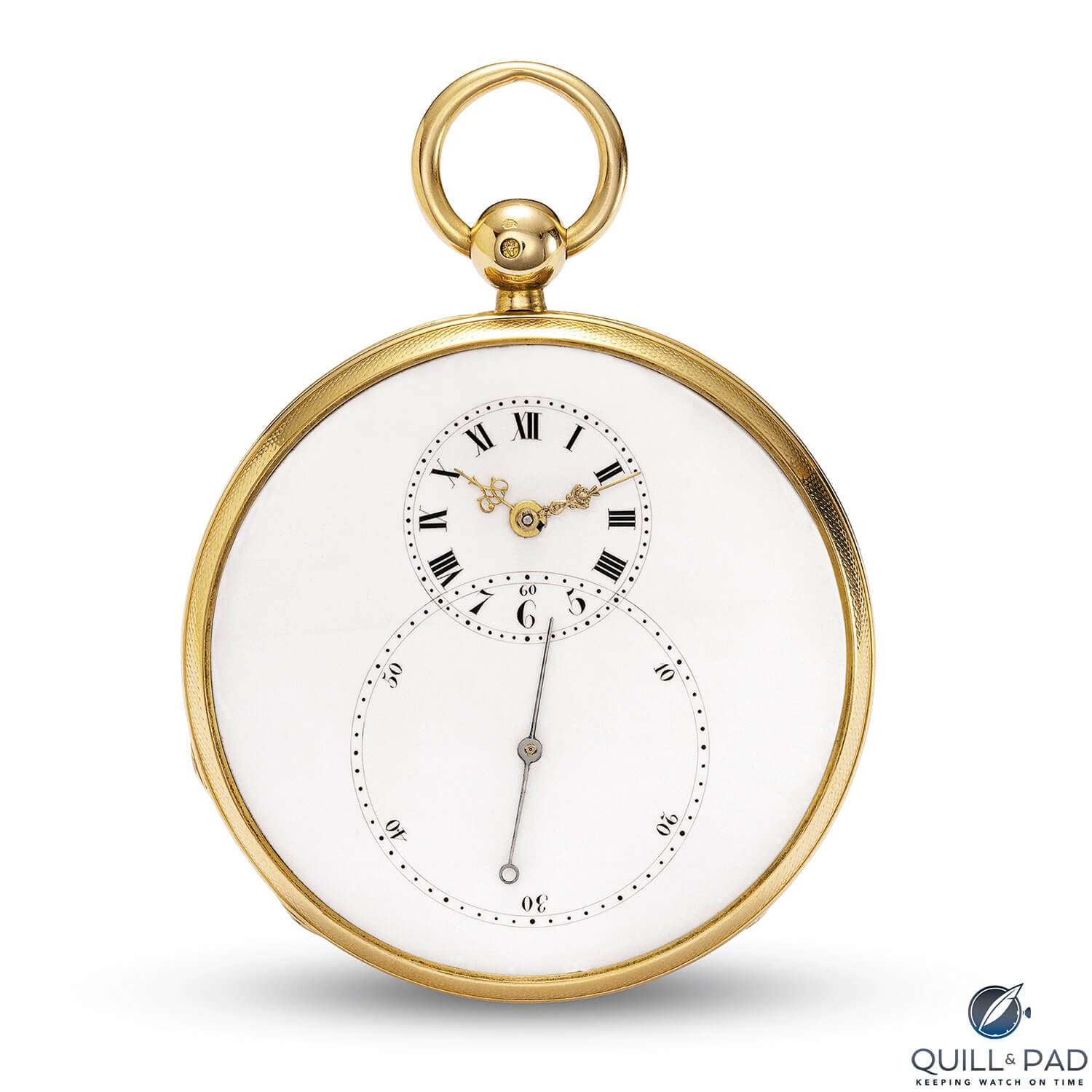
The design of this historic Jaquet Droz pocket watch from 1784 spawned the Grande Seconde line
This extensive line encompasses many different versions, all striking in their modern, minimalistic simplicity. The Grande Seconde Enamel models enhance the beatific countenance of the timepiece with pure and artistic depth. The Off-Centered model is fascinating in the use of a slight off-centred tilt, particularly against the backdrop of a mysterious deep black onyx.
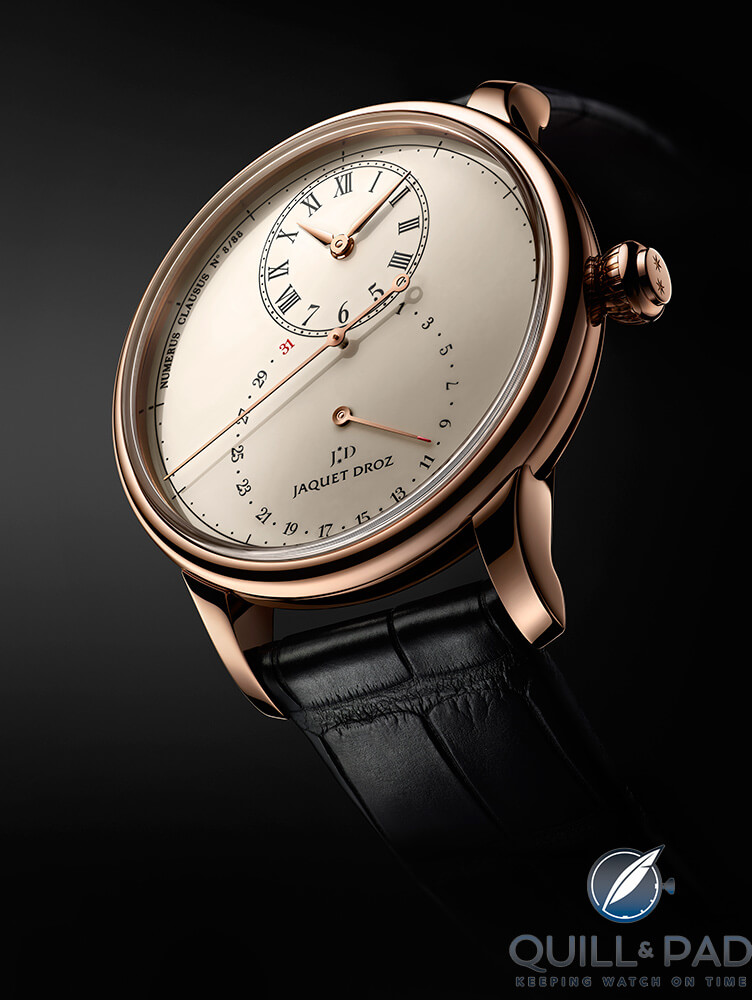
Jaquet Droz Grande Seconde Deadbeat
But perhaps most intriguing (for me, anyway) is the Grande Seconde Deadbeat with clever mechanics causing the second hand to move in the same way as that of a traditional high-precision clock. “Jumping seconds,” as this is also known, is a rare, playful, and precious addition to a mechanical caliber.
High mechanics: the Bird Repeater, the Charming Bird, and the Loving Butterfly
The mechanical movement of the Bird Repeater, introduced in late 2012, includes a tourbillon and a repeater: the latter simultaneously moves the bird automata that replicate a Jura bird species called mésange. The moving birds are set against a waterfall background, a beautiful play of water that also exists in the region called le Saut du Doubs.
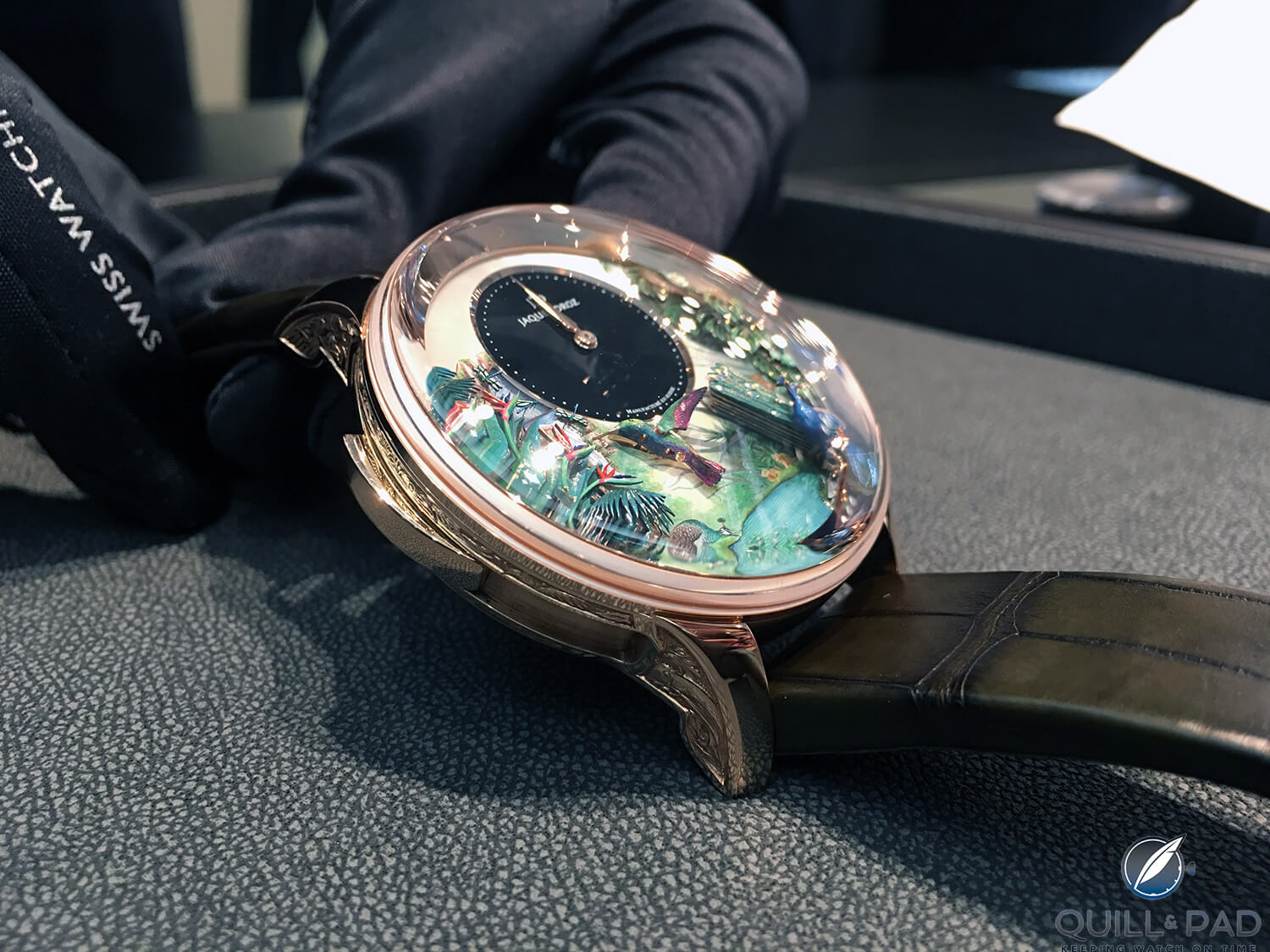
Jaquet Droz Tropical Repeater
See the latest version of this oeuvre, which launched in December 2017 to celebrate the brand’s 180th anniversary, in Jaquet Droz Goes Paradise Lush With The Extraordinary Tropical Bird Repeater.
The Charming Bird, which won the Mechanical Exception prize at the 2015 Grand Prix d’Horlogerie de Genève, is based on the brand adding a singing bird cozily ensconced within a sapphire crystal dome (“cage”) especially conceived to enhance the effect of light passing through it to a wristwatch. This is obviously no mean feat.
Each one of the little songbirds needs 20 hours of loving care by an in-house artisan, who engraves the animal’s feather, head, and delicate tail. Tiny strokes of paint are added to complete the illusion.
The meticulously crafted Loving Butterfly docks into two of Jaquet Droz’s most famous traditions: automata and the butterfly. The 43 mm white or pink gold timepiece sees a delicate butterfly come to life, flapping its wings 300 times over the course of two minutes once the button in the crown is pushed. Additionally, the meticulously hand-engraved 40 individual parts of the little cherub appear to move thanks to the turning chariot wheel that is driven from the same barrel as the butterfly.
The entire hypnotic scene, glowing against the backdrop of an onyx or Polynesian black mother-of-pearl dial, is driven by a spectacular automatic movement, which you can find out more about in Awesome Aphidae: Jaquet Droz’s Loving Butterfly Returns As An Exquisite Automaton.
For more information, please visit www.jaquet-droz.com.
Quick Facts Jaquet Droz Grande Seconde Deadbeat
Case: 43 x 13.79 mm, red gold
Movement: automatic Caliber 2695SMR with dead beat seconds and silicon balance spring; 40 hours power reserve; 21,600 vph
Functions: hours, minutes (subdial at 12 o’clock), seconds (sweep hand); date
Limitation: 88 pieces
Price: 29,000 Swiss francs without VAT
Quick Facts Jaquet Droz Charming Bird
Case: 47 mm, white gold
Movement: automatic Jaquet Droz Caliber 615 with silicon balance spring and pallets; a second manually wound movement powers the bird automaton
Functions: hours, minutes; singing bird
Limitation: 28 pieces
Price: 380,000 Swiss francs
Quick Facts Loving Butterfly
Case: 43 x 16.63 mm, white or red gold
Dial: onyx or Polynesian black mother-of-pearl dial
Movement: automatic Caliber 2653 ATI with silicon balance spring and pallet lever, double spring barrel, 68-hour power reserve plus manually wound automaton with its own spring barrel activated by pushing the crown button
Functions: hours, minutes; cherub-and-butterfly automaton
Limitation: 28 pieces in each case metal
Price: $126,000
You may also enjoy:
Jaquet Droz Petite Heure Minute Relief Dragon: Forged In Fire
All About Automata: Mechanical Magic (With Action Videos)
Jaquet Droz Loving Butterfly Automaton: Millions Of Years In The Making
Leave a Reply
Want to join the discussion?Feel free to contribute!





















































The JD automatons are a species of their own, mechanical machines, breathtaking creatures of artistry and craftsmanship. Many times I try to imagine how supernatural they must have been perceived by the people of the 18th century – a new definition of humanity and technology.
And I am always delighted, dear Elizabeth, by your articles about everything from Jaquet Droz. This brand is so beautiful and unique – outstanding among so many other brands and designs in the industry. A great pleasure for me. Thank you. Thomas.
While a great brand with truly impressive heritage and body of work, both old and new, isn’t it a bit misleading to say 300 years of.. if there’s a 179 year hiatus?
Guilty, Sebastian, it’s actually the 300-year anniversary of Pierre Jaquet-Droz’s birth but I didn’t think that was a punchy enough title.
Regards, Ian